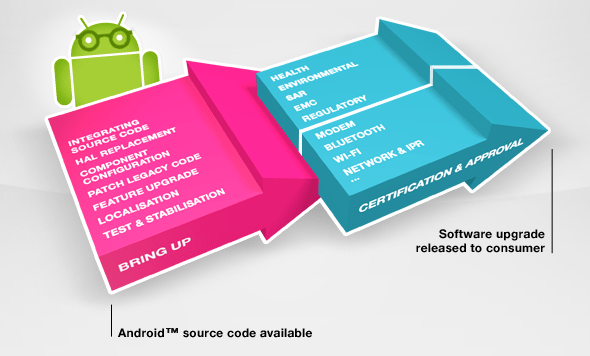The era of Ice Cream Sandwich is upon us, and while some of us are waiting diligently for our Galaxy Nexuses to to arrive, others are left pondering a more different question: when will my device get Android 4.0?
Sony Ericsson (soon to be just Sony) and Motorola have heard our pleas, and have both gone into lengthy tirades about how the Ice Cream Sandwich process actually works and how long it takes, albeit without juicy details like dates.
Though they both go about it in different ways — Sony Ericsson’s explanation delves into more technical territory, while Motorola’s is more accessible — they essentially outline the same multi-step process. I’d recommend Android junkies take a look at both just for the nitty gritty details, but here’s the TL;DR version of how the upgrade process works.
Get it working: It wasn’t long ago that Google released the AOSP version of Ice Cream Sandwich, and at that point vendors began to work on getting it running on the devices that they have decided will get the upgrade. For Motorola, this means the Droid RAZR, the Droid Bionic, the original XOOMs, and the new XYBOARDs. Meanwhile, Sony Ericsson will be updating their entire 2011 Xperia line. At this point, they’ll also be working on integrating manufacturer-specific tweaks, and making sure all the basics (phone calls, SMS, data connections) work properly.
Squash the bugs: Now that ICS is up-and-running, it’s up to the vendors to make sure it runs as smoothly as possible. This includes (mong other things) applying patches and fixes, making sure downloaded apps run properly, and the extensive testing different use-cases for stability.
Submit for certification: Once all the heavy lifting is done, it’s off to the network operators for certification. This is probably the most time-consuming of all the steps since they have to extensively test the update, and the process can differ from carrier to carrier. It can take longer still for companies who launch the same devices in multiple countries. The updates also have to be certified to show that they are compliant with a given regulatory body’s technical standards (like Bluetooth, WiFi, etc.).
Push it out: The best part (at least from my point of view). With everyone having signed off on the update, it gets released for end-users to download.
Though very informative, Eurodroid points out that their explanations also seem to serve as something of a mea culpa — getting all these devices to run Android 4.0 takes a lot of work, so sorry for the (inevitable) wait.
